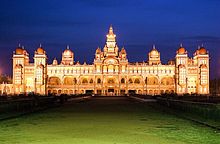Mysore (District)
| Mysore District ಮೈಸೂರು ಜಿಲ್ಲೆ |
|
|---|---|

|
|
| State | Karnataka |
| Division : | Mysore |
| Administrative headquarters : | Mysore |
| Area : | 6,853 km² |
| Residents : | 2,994,744 (2001) |
| Population density : | 437 inhabitants / km² |
| Website : | mysore.nic.in |
The district of Mysore ( Kannada : ಮೈಸೂರು ಜಿಲ್ಲೆ ) is a district of the Indian state of Karnataka . The administrative center is the eponymous Mysore (Mysuru), the second largest city of Karnataka.
geography
The district of Mysore is located in the south of Karnataka in the southernmost part of the Dekkan Plateau. Neighboring districts are Kodagu in the west, Hassan in the north, Mandya in the northeast, Chamarajanagar in the southeast and Wayanad in the southwest. The latter already belongs to the neighboring state of Kerala .
The district area has an area of 6,853 square kilometers and forms a gently undulating plateau with an average height of 700 to 900 meters above sea level. Foothills of the Western Ghats , which reach heights of up to 1200 meters, partially protrude into the Mysore district. Over a third of the district area is forested. Mysore District also includes part of Nagarhole National Park , which is a refuge for wild animals such as tigers, leopards and elephants. The Kaveri River , one of the main rivers of southern India, flows through the northern part of the district . The Kaveri is dammed up to the Krishnarajasagara reservoir on the border with the Mandya district .
The district of Mysore is divided into the seven taluks Heggadadevanakote, Hunsur, Krishnarajanagar, Mysore, Nanjangud, Piriyapatna and Tirumakudal-Narsipur.
history
During the British colonial period , the district belonged to the princely state of Mysore . In 1939, the Mandya district was detached from the Mysore district as a separate district. After Indian independence, the princely state of Mysore joined the Indian Union in 1949. As a result of the reorganization of the Indian federal states, the district of Mysore became part of the state of Mysore (renamed Karnataka in 1973 ) after the language borders of the Kannada . In 1997, the southern part of the Mysore District split off as the Chamarajanagar District .
population
According to the 2011 Indian census, the Mysore district has 2,994,744 inhabitants. This makes it the third largest district of Karnataka after Bengaluru Urban and Belgaum . Between 2001 and 2011, the population grew by 13.4 percent and thus only slightly more slowly than the state average (15.7 percent). The population density of 437 inhabitants per square kilometer is above the average of Karnataka (319 inhabitants per square kilometer). 41.4 percent of the residents of the Mysore district live in cities. The degree of urbanization is thus higher than the mean for the state (38.6 percent). At 72.6 percent, the literacy rate is below the average in Karnataka (76.1 percent).
According to the 2001 census, Hindus make up a large majority of 87.4 percent of the residents of the district . For Islam to 8.9 percent of the population profess. A smaller minority are Buddhists with 1.4 percent. Most of them are descendants of Tibetan refugees who were settled in Bylakuppe and other places in the Mysore district by the Indian government in the 1950s and 1960s . The 2001 census classified 10.3 percent of the district population as members of the tribal population (cf. Adivasi ). Most of them are members of the Naikda and some Jenu Kuruba .
Attractions
The main attraction of the district is the city of Mysore. The former Maharaja's residence attracts numerous tourists thanks to magnificent buildings such as the City Palace ( Amba Vilas ) completed in 1912 . On the edge of Mysore rises the 1,062 meter high local mountain Chamundi Hill , on the summit of which there is a popular pilgrimage destination with the Chamundeshwari Temple . The 13th century Keshava Temple in Somanathapura, around 35 kilometers east of Mysore, is a reminder of the rule of the Hoysala and is one of the most important examples of Hoysala architecture , along with the temples of Halebid and Belur .
Cities
| city | Population (2001) |
|---|---|
| Bannur | 23,190 |
| Belvata | 5,627 |
| Bhogadi | 4,813 |
| Hebbalu | 1,471 |
| Heggadadevanakote | 12,043 |
| Hunsur | 43,893 |
| Krishnarajanagar | 30,603 |
| Mysore | 742.261 |
| Nanjangud | 48,220 |
| Piriyapatna | 14,922 |
| Tirumakudal-Narsipur | 9,930 |
literature
- The Imperial Gazetteer of India. Volume 18: Moram to Nayāgarh. New edition, Clarendon Press, Oxford 1908, pp. 250-259 , keyword: Mysore District .
Web links
Individual evidence
- ↑ Census of India 2011: Provisional Population Totals: Data Sheet (PDF; 1.7 MB) and Population and decadal growth rate by residence Persons. (PDF; 1.3 MB)
- ^ Census of India 2001: Basic Data Sheet. District Mysore (26), Karnataka (29). (PDF; 55 kB)
- ↑ Census of India 2001: Population, population in the age group 0-6 and literates by sex - Cities / Towns (in alphabetic order) ( Memento from June 16, 2004 in the Internet Archive )


